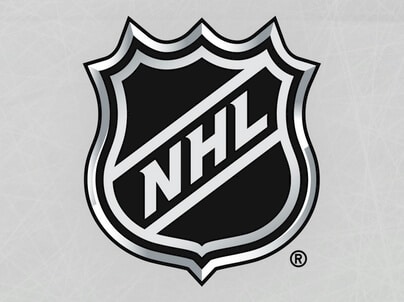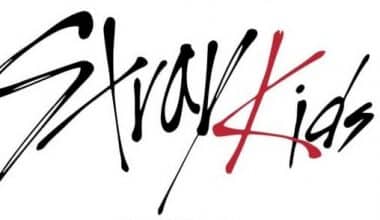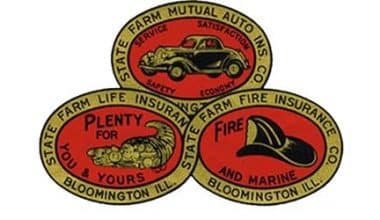The National Hockey League (NHL) is one of the most popular professional sports leagues in the world. The league has a long and rich history, and its logo is one of the most iconic in sports. But, so we get a clearer picture of what the logo and brand stand for, this article will discuss the history of the NHL logo and how it has evolved over the years. We will also go over the meaning of the logo and how it represents the NHL and its fans.
The Evolution of the NHL Logo
1917-1946 (The First Concept)
The NHL’s first original logo was designed in 1971 and wasn’t too dissimilar to the logo we know today. The color choices are the most noticeable difference in this. Yellow, white, and sleek black are used in the logo. The yellow wordmark is placed diagonally against the black background in the center of a sleek black crest.
Outside the letters are two parallel lines, and all three letters are capitalized. The lines emphasized the letters inside, and the black background made the yellow letters stand out. A white outline with a smaller black border around the outer edge surrounded the crest. This initial logo was simple, sleek, delicate, and well-executed.
1946-2005 (The First Change)
The league used the first logo for a while before deciding it was time to change and redesign it. This redesign retained the same concept, a crest with letters inside, but the design was slightly altered. They changed the shape of the crest, making it both wider and shorter.
They removed all white from the logo and increased the intensity of the yellow. The black background was smoother, with the white outline removed, and the yellow shade stood out more prominently. The most recent change was to the typeface, which was now bolder and longer. The shield elements were now slightly raised in the corners, and the logo was bolder and more modern.
2005–Present: The NHL Logo
When the NHL rebranded in 2005, the most recent design was used. The logo was changed in tandem with the rest of the brand’s redesign, and it received a complete refresh for the first time. Although the brand chose to keep the crest, it significantly changed the rest of the design. They chose to keep the shield’s shape, which was elegant, strong, and bold. They chose to replace the dark yellow shade with silver instead. The logo now appeared bold, powerful, sleek, and elegant.
The typeface was also changed to a more elegant and sleek one to match the design. The letters and the lines have been repositioned, now written from the bottom up and slanted to the right. These modifications represented the brand’s development and progression. However, it retained enough of the original logo to remain familiar and recognizable to those following along since the beginning.
The only difference between the two logos is that the abbreviation is changed to “LNH” in Canada.
The NHL Logo Elements
The Significance
Like any great logo, the NHL logo carries a lot of weight. The famous shield logo began in black and orange and has gradually evolved into something we’re all familiar with. The symbol is crucial in developing a visual identity that expresses the brand and has helped it become as recognizable as it is today. The symbol’s elements include a bold shield that adds a fierce drive to the logo and name.
The Typeface
When it comes to logos, the font is extremely important without a strong font that accurately represents the brand and easily ties into the design. The font is important, and it must fit the brand, its personality, and its design. It’s also essential that it can be used on various materials and looks good no matter where it’s displayed or used. The custom font used for the NHL logo is neither serif nor sans serif. Each letter has only one serif, while the other parts have none.
Colors
Color is an essential part of any design, especially a brand’s logo. Colors for the NHL logo had to be versatile while also displaying the brand. Although the logo has undergone several color schemes, we see a simple black-and-white scheme today. The logo incorporates silvery shades of grey, but the colors are otherwise simple, clean, and clear.
The NHL’s (National Hockey League) History
The NHL is a men’s professional ice hockey league. It was founded in 1917 in Montreal, Quebec, Canada, and is regarded as the world’s best hockey league. The league currently has 32 franchises, with 25 in the United States and 7 in Canada.
The Montreal Canadiens, Ottawa Senators, Toronto Maple Leafs, Edmonton Oilers, Winnipeg Jets, Vancouver Canucks, and Calgary Flames are among the Canadian teams in the league. Every year, all teams compete for the Stanley Cup, North America’s oldest professional sports trophy.
History from 1917 to 1941
The NHL was established on November 26, 1917, in Montreal, Quebec, Canada, to replace the NHA (National Hockey Association), which had failed due to a feud between Toronto Blueshirts owner Eddie Livingstone and the owners of the league’s other teams.
Montreal Wanderers, Montreal Canadiens, Toronto Arenas (predecessor to Toronto Maple Leafs), and Ottawa Senators were among the NHL’s founding members. Quebec City had a franchise but chose not to play in the inaugural season. During the same season, NHL teams competed for the coveted Stanley Cup against teams from other professional hockey leagues.
Over the next quarter-century, the NHL’s composition, play-off format, and scheduling underwent numerous changes. The Boston Bruins were the first American team to join the NHL in 1924, and within two years, six of the ten teams were American. The Ottawa Senators dominated the 1920s, winning six league championships and four Stanley Cups. Unfortunately, the team was disbanded in 1934.
Charlie Conacher, Frank “King” Clancy, Lester Patrick, Aurele Joliat, Nels Stewart, and Bill Cook were all outstanding players at the time. Howie Morenz was the most visible player, while Eddie Shore was the best defender.
1942-1967
The NHL had only six teams remaining in 1967: the Toronto Maple Leafs, Montreal Canadiens, Chicago Black Hawks, Boston Bruins, New York Rangers, and Detroit Red Wings. For 25 years, the league remained in this format. When the league added six expansion teams in 1967, the previous six franchises were dubbed the “Original Six.”
The Toronto Maple Leafs were the dominant team of the 1940s, led by Max Bentley, Ted Kennedy, Syl Apps, and Walter “Turk” Broda. Within ten years, they won the Stanley Cup six times. However, Maurice “Rocket” Richard was the most outstanding offensive player of the era, scoring 50 goals in 50 games for the Montreal Canadiens in 1944-45, including five goals and three assists in a single game.
Larry Kwong broke the color barrier by playing for the New York Rangers in 1948. Willie O’Ree, who played for the Boston Bruins a decade later, became the league’s first African-American player.
Read Also: M&M Logo: History, Evolution & All You Need
The Detroit Red Wings, led by Gordie Howe, Ted Lindsay, Terry Sawchuck, and Red Kelly, dominated the early 1950s. The Montreal Canadiens assembled arguably the best team in NHL history in the mid-1950s, featuring Henri Richard, Jean Beliveau, Bernie Geoffrion, Dickie Moore, Dougie Harvey, Jacques Plante, and many others. The team won six Stanley Cups, including five in a row (1955-56 to 1959-60).
The Chicago Black Hawks ushered in the decade with their first Stanley Cup in 23 years in 1960-61, led by the outstandingly talented Glen Hall, Stan Mikita, and Bobby Hull. Before the league’s expansion in 1967, the Toronto Maple Leafs won four more Stanley Cups, and the Montreal Canadiens won two more.
NHL Evolution and Expansion (1967-1990)
Six new teams from the United States joined the NHL in 1967: the Los Angeles Kings, the California Seals (later the Oakland Seals), the Philadelphia Flyers, the Minnesota North Stars, the St. Louis Blues, and the Pittsburgh Penguins. Vancouver Canucks and Buffalo Sabres joined in 1970, and New York Islanders and Atlanta Flames joined two years later.
The Washington Capitals and Kansas City Scouts joined the NHL in 1974, bringing the total number of teams to 18, with only three from Canada. The Montreal Canadiens ruled the roost then, winning eight NHL championships between 1967 and 1979.
In 1979, the NHL merged with the WHA (World Hockey Association), expanding again. When it was founded in 1971, the WHA broke the NHL’s stranglehold on professional hockey. Several former NHL players played in the first WHA season, including stars like Bernie Parent, Bobby Hull, Brian Conacher, and John McKenzie. Hockey legend Gordie Howe relocated to Houston with his sons Mark and Marty the following season.
The WHA began with 12 teams and grew to 14 before dwindling attendance and rising costs reduced the league to 7 teams in the 1978-79 season. The WHA ceased operations in 1979 when it merged with the NHL. The NHL acquired the Harford Whalers, Quebec Nordiques, Edmonton Oilers, and Winnipeg Jets.
When the Atlanta Flames relocated to Calgary in 1980, the number of Canadian NHL teams increased to seven. The Edmonton Oilers became the first former WHA team to win the Stanley Cup in 1983-84, ending the New York Islanders’ four-year reign.
Read Also: UnitedHealth Group Logo: Evolution & History
The Oilers, led by stars like Wayne Gretzky and Mark Messier, won the Stanley Cup four of the next six seasons. The Pittsburgh Penguins were the dominant team in the early 1990s, winning two consecutive Stanley Cups in 1990-91 and 1991-92 and a record 17 straight games in 1992-93. Since then, the record has not been broken.
Ice hockey has become more focused on offensive play and scoring. In the 1970s, Boston Bruins’ Phil Esposito set new records for points (152) and goals (76) in the 1970-71 season, while defenseman Bobby Orr reinvented himself, becoming the league’s first defensive player to score the most goals in 1970 and 1975.
The incredible scoring achievements of Wayne Gretzky and Mario Lemieux in the 1980s epitomized the emphasis on offense in ice hockey. In particular, Wayne Gretzky’s scoring prowess is perhaps unparalleled in any sport. With 2,857 points, he is the NHL’s all-time leading scorer and the only player to reach 2,000 career points. Furthermore, he shares or holds 61 NHL records, including the most goals and assists—894 and 1963, respectively.
NHL Evolution and Expansion Since 1990
The NHL expanded further in 1991 and 1992, increasing the number of teams to 26. The Ottawa Senators, another Canadian franchise, joined the league. The Florida Panthers (Miami), Sharks (San Jose), Mighty Ducks (Anaheim), and Lighting (Tampa Bay) were also given franchises.
The Quebec Nordiques struggled financially in 1995 because they played in the league’s smallest market. They were sold the following year and relocated to Denver, where they were known as the Avalanche. The Winnipeg Jets relocated the following year after being purchased by a Phoenix consortium. They were renamed the Phoenix Coyotes (later Arizona Coyotes), leaving Canada with only six franchises.
The NHL announced plans to expand to four more cities in the United States in the summer of 1997. The league had grown to 30 teams by 2000, with the addition of the Nashville Predators in 1998, Atlanta Thrashers in 1999, and Columbus Blue Jackets and Minnesota Wild in 2000.
In 2011, the Atlanta Thrashers relocated to Winnipeg, and the name Winnipeg Jets was reinstated. The NHL announced in 2016 that a new Las Vegas franchise, the Vegas Golden Knights, would join the league ahead of the 2017-18 season, bringing the total number of teams to 31.
Conclusion
The NHL (National Hockey League) is a professional ice hockey league in North America, with 32 teams: seven in Canada and twenty-five in the United States. The NHL is widely regarded as the best hockey league in the world and one of the most important sports leagues in Canada and the United States. At the end of each season, the Stanley Cup, North America’s oldest sports trophy, is presented to the winner of the NHL playoffs.
The NHL first entered the United States in 1924 with the establishment of the Boston Bruins. By 1926, the league had grown to include ten teams from the Northern United States, the Great Lakes region, and Ontario, Quebec.
Between 1942 and 1967, the NHL had only six teams, known as the “Original Six.” The NHL expanded to six new teams in 1967. The league expanded again in 1974 and 1979, to 18 and 21, respectively. From 1991 to 2000, the NHL grew to include 30 teams. The league had 32 teams as of 2021.
The NHL is the world’s fifth-richest professional sports league in terms of revenue, trailing only the NFL (National Football League), MLB (Major League Baseball), NBA (National Basketball Association), and EPL (English Premier League).
Related Articles
- TAMPA BAY LIGHTNING LOGO: History and Everything you Need to Know
- Top 12 steps to financial freedom in 2023(+financial freedom books)
- WHICH SPORTS MAKE THE MOST MONEY: 10 Highest Paid Sports in the World
- CANADIAN BEER BRANDS: 20 Best, Old and Cheap Brands in 2023 (Updated)
- SEATTLE KRAKEN LOGO: Concept, Record, and What You Should Know






